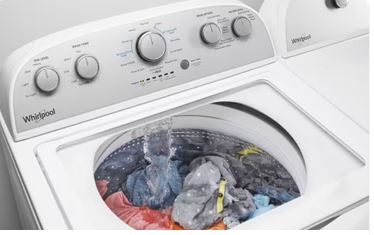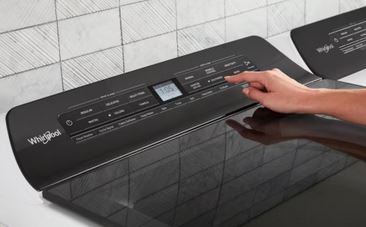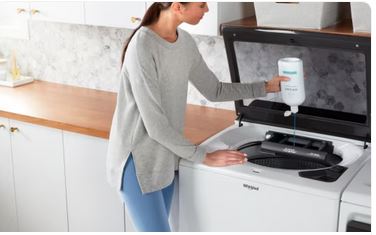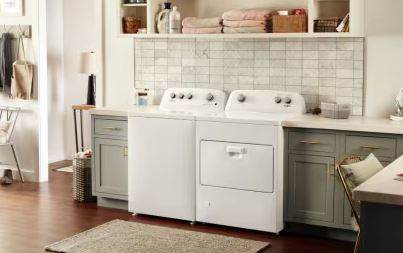Whirlpool Cabrio washers are known for their reliability, efficiency, and cleaning prowess. Sadly, sometimes these washers malfunction and one malfunction is a Whirlpool Cabrio washer not spinning, and you’ve to wonder why.
Your Whirlpool Cabrio washer may fail to spin due to a power issue, an unlevelled washer, load imbalance, an overload, excessive suds, a wrong setting, a drainage problem, or a defective latch/lid switch, drive belt, or motor coupling.
While this leaves you with a pile of wet clothes that are probably dirty, the best part is that you can troubleshoot the issue DIY. Some issues only need a simple fix, while others require a component replacement.
This guide shall take you through the ten issues that cause your washer to fail to spin and the applicable fixes.
Here we go!

Are you in a rush? Below is a table summary of the ten reasons why your Whirlpool Cabrio washer isn’t spinning and their fixes
Troubleshooting Guide to A Non-Spinning Whirlpool Cabrio Washer
| – | Likely Cause | Quick Fix |
| 1. | Power Issue | Just ensure your washer has power (turns on) |
| 2. | Unlevelled Washer | Ensure the washer sits steady on uniform ground. |
| 3. | Unbalanced Load | Redistribute your laundry evenly |
| 4. | Washer Overload | Don’t exceed the washer’s ¾ capacity. |
| 5. | Excess Suds | Only use High-Efficiency detergent and in the right amount |
| 6. | Wrong Setting | Choose the right spin and wash setting that matches your load |
| 7. | Drainage Problem | Clear any blockage in the drain filter, hose, and pump. And replace any damaged part |
| 8. | Faulty Latch/Switch | Replace the latch in case of physical damage. If the switch lacks continuity, replace it |
| 9. | Defective Drive Belt | Replace the drive belt |
| 10. | Faulty Motor Coupling | Replace the motor coupling |
Why is My Whirlpool Cabrio Washer Not Spinning?
Below are the ten reasons why a Whirlpool Cabrio washer fails to spin the clothes:
1. Power Issues
Is your Whirlpool Cabrio washer not spinning or agitating? Then, it could be a power issue.
That is true, especially if you get soaking wet laundry after a spin cycle ends. If the power goes when the washer is on, it won’t spin again until it returns and you restart the cycle.
Another issue is the electric outlet. If it’s under voltage (under 120v), your washer won’t have enough power to spin the clothes.
If that’s not the case, it could be that you are using an extension cord. This is because extension cords do not transmit enough power to your washer.
Quick Fix
Wait for power to be back in case of an outage. If that’s not it, check the electric outlet voltage level using a voltmeter, and if it’s below 120v, call an electrician to fix it for you. If you use an extension cord, avoid it and hook it into the wall socket instead.
2. Unlevelled Washer
Nothing wastes time and money like a washer that’s not on level. Wondering how? A washer that isn’t entirely on level does not spin properly. This means you will have extended wash cycles.
However, you can tell an unstable washer by listening to its sound during spinning. If it’s excessively noisy or makes violent vibrations when running, it’s evident that it’s not resting correctly on the floor.
Quick Fix
Use a spirit level to check if the washer legs are touching the ground. If not, adjust them until they all touch the ground. If the floor isn’t flat, find a more balanced ground and move your washer.
3. Unbalanced Load
Another reason for a non-spinning washer is user error. That happens when you load your washer without arranging or distributing the laundry uniformly, creating a load jam that shudders during spinning. However, sometimes, the Whirlpool Cabrio washer stays in sensing mode, which means a no spin.
Quick Fix
The fix is simple. Stop the washer, open its lid, and redistribute the laundry evenly.

4. Washer Overload
A washer overload can also cause a reduction in spin speed, just like an unbalanced load. Understandably, we want to wash everything in the laundry basket. However, it’s also good to remember that overloading your washer causes more harm.
First, the washer struggles to spin, and you will likely get poorly washed and dripping wet laundry. Second, you put your washer at risk of severe damage to the internal parts, which can break due to the excessive force the washer is using to spin the clothes.
Quick Fix
Stop the washer and remove some clothes (especially the bulky items like sheets). Always follow your manufacturer’s instructions on washer capacity or put it at ¾ full.
5. Excess Suds
For cleaner clothes, detergent is a must-have. That said, too much detergent or using non-HE detergent forms excessive suds. When this happens, false information is sent to your washer, telling it it’s full, making it hard to spin the clothes.
That’s not all! Excessive suds also make your clothes retain excessive moisture and could be why you have soaking wet clothes.
Quick Fix
Only use High Efficiency (HE) detergent and in the proper proportions.
6. Wrong Wash Setting
Sometimes, you may select the wrong wash settings on the control panel. For example, you reduce the spin power by choosing Hand Wash or Delicate settings while washing bulky or heavy clothes.
Other settings have no spin speed. So, if you choose such a setting while washing bulky items, your washer won’t spin, and you will get dripping wet laundry at the end of a spin cycle.
Quick Fix
Ensure you pick the correct spin and the wash setting.
7. Drainage Issue
If there’s an issue in the drainage system, your Whirlpool Cabrio washer won’t spin or will struggle to turn. You can rule out a drainage issue by checking the following:
- Clogged filter – Your washer has a filter that prevents any foreign object from flowing to the drain hose. Over time, this filter may accumulate dirt, lint, or debris, thus blocking it and forbidding wastewater from flowing through it.
- Kinked or clogged hose – Check the drain hose to see if the filter is okay. It could be cracked or clogged by dust, dirt, or debris, which disallows water flow.
- Extended hose height – If the hose is free from kinks and clogging, it’s time to check its height. The drain hose height should be 96 inches or 8 feet long. If it’s beyond that, it allows backflow of wastewater.
- Faulty drain pump – If you’ve checked the above and your Whirlpool Cabrio washer still won’t spin, the answer is in the drain pump. Check the pump for clogging or physical damage.
Quick Fix
Clean the filter and hose in case of clogging. You can use a sump pump to drain excess water in case of an extended hose, and ensure you call a technician to help you install it correctly before your next laundry day.
Lastly, if the pump is clogged, use a drain snake to unclog it, but if it has physical signs of wear and damage, replace it.

8. Faulty Latch/Lid Switch
If the issue is none of the above and your washer won’t spin, it’s time to consider a defective component. The first part you should look at is the latch or the switch.
The latch and the lid switch protect your washer by hindering it from operating when open. If any of these parts is faulty, it prohibits your washer from spinning.
Quick Fix
Check the latch for any physical damage or wear and replace it if damaged. If the latch is okay, use a multimeter to test for a possible lid lock switch problem and replace it if it shows no continuity.
9. Defective Drive Belt
Another part intertwined with spinning is the drive belt. The belt is located at the washer’s bottom and rotates the drum during spinning.
So, check the drive belt if your Whirlpool Cabrio washer is not spinning water out of clothes.The belt can wear naturally due to frequent washer usage, which weakens and loosens it, reducing its spinning effect.
Damage can also rob the belt’s maximum functionality and could be why your washer isn’t spinning.
Quick Fix
Get a new belt that matches the older one, then unplug your washer from power, access its bottom, remove the old belt, and replace it with a new one.
10. Faulty Motor Coupling
Another part in question for a non-spinning washer should be the motor coupling. This part connects the motor to its transmission, aiding the washer in spinning.
However, since it comprises plastic parts and rubber isolators, it can wear naturally due to frequent washer usage.
Load imbalance and washer overloading are other things that shorten the life of the motor coupling. You can tell a faulty motor coupling if your washer runs without agitating.
Quick Fix
In case of any damage to the motor coupling, you need to replace it.
Whirlpool Cabrio Washer Not Spinning Clothes Dry
If your Whirlpool Cabrio washer isn’t spinning, you will likely get soaking-wet laundry at the end of a wash cycle. This is primarily due to power issues, an unlevelled washer, unbalanced load, washer overload, excess suds, or wrong settings.
If it’s neither of these, it could be due to a malfunction, including a faulty latch or lid switch, drainage problems, a defective drive belt, or a defective motor coupling.
Whirlpool Cabrio Washer Not Spinning Fast Enough
Various reasons explain why your Whirlpool Cabrio washer doesn’t spin fast enough. That includes an unleveled washer, unbalanced load, washer overload, or wrong setting. Moreover, a faulty drive belt or slow drainage could also trigger its slow spin.

How to Fix a Whirlpool Cabrio Washer That Won’t Spin?
As seen in the fixes above, you can fix a Whirlpool Cabrio washer that won’t spin by:
- Ensuring your Cabrio washer has power
- Ensuring your washer stands on level ground with all legs touching the floor
- Redistributing the load evenly before starting the cycle
- Ensuring you fill your washer to ¾ full
- Using the suitable detergent (HE) in the right amount
- Choosing the correct wash and spin setting
- Replacing a damaged latch and a faulty lid switch
- Fixing any drainage issue
- Replacing a damaged drive belt
- Replacing a defective motor coupling
Concluding Thought On a Whirlpool Cabrio Washer Not Spinning
As seen, your Whirlpool Cabrio washer fails to spin due to power issues, an unlevelled washer, unbalanced load, washer overload, excess suds, or wrong wash and spin settings. It could also be due to a part malfunction, including a faulty latch/lid switch, drainage problem, defective drive belt, or faulty motor coupling.
Also Read:
